“It isn’t the mountains ahead to climb that wear you out; it’s the pebble in your shoe.” -Muhammad Ali
It may have been another fun week here at Starts With A Bang, where I've just learned something fun: I have an Erdös-Bacon number of nine! On the academic side, I published with Jim Fry, who published with Jim Peebles, who published with Bob Dicke, who published with Albert Einstein, who published with Ernst Straus, who published with Paul Erdös, giving me an Erdös number of six. But on the TV side, I was on Good Day Sacramento with Cody Stark, who appeared with Dolly Parton on Good Day Sacramento, who appeared in the 1984 Academy Awards with Kevin Bacon, giving me a Bacon number of 3. (Including TV.) Not bad!
I'm getting over a cold, but that doesn't mean we saw anything slip this week; instead, we covered the following:
- Is there really evidence for a new, fifth force? (for Ask Ethan),
- From nothing to you in 12 easy steps (for Mostly Mute Monday),
- The Milky Way: invisible to most of us but accessible to all,
- LIGO's second black hole merger leaves no doubt: Einstein was right!,
- Second gravitational wave makes it official: merging black holes don't burst, and
- Is dark matter required for life to exist?
I've got a tremendous new book announcement coming soon (fingers crossed!), and now it's onto your 114th edition of our Comments of the week!
From Michael Kelsey on galactic rotation: "“Great timescales” prevent us from measuring _face-on_ galaxies’ rotations [...] Why? Because it takes galaxies about 200 million years to undergo a single rotation (i.e., a typical star’s orbit), and if we see the galaxy face on, we can’t use spectroscopy to measure the stars’ differential motions on either side of the galaxy. We could only (hypothetically) measure their motion across our field of view, which would require tens of millions of years."
What's interesting is that although this is true, and makes complete sense, it was claimed that internal motions were not only measurable, but were well-measured back in the 1910s!
When the Great Debate happened in 1920, this was a major piece of evidence that was used to discredit Heber Curtis' position, since if these "galaxies" were so large and so distant, it would be impossible to observe these motions without there being a faster-than-light motion, which is disallowed by relativity. By 1921, van Maanen has published four robust galaxy rotations for face-on galaxies, with tiny, tiny error bars.
Absurd! Incorrect! And yet, right at the limits of what we thought we could see, here was a claimed signal, based on scores of measured points for each galaxy!
What happened? The simplest explanation is the most common one running through scientific history: we fooled ourselves with a barely-observable effect right at the limits of our measurement sensitivity. This is what's worth noting: that measurement that aren't independently repeated and significant enough to be beyond all reasonable statistical or systematic doubts shouldn't be trusted, especially if they would cause something new or novel to exist. This extends to the OPERA faster-than-light neutrinos recently, this extends to the evidence for the new "5th force" that has yet to be verified, and this extends to the "diphoton bump" at the LHC. Don't jump to early conclusions, but rather stay tuned for more and better science!
From Denier on WFIRST: "While we may get some nice images out of WFIRST, its currently structured development is a boondoggle. The NRO donated, completely free of cost, two KH-11 telescopes roughly the size of Hubble. NASA should have bolted on the best cameras they had at the time and strapped them to the first Delta IV headed up."
This is quite a misinformed comment on Denier's part, I regret to say. First off, WFIRST is using one of those NRO 2.4 meter, Hubble-class telescopes for its optical telescope assembly. This mission has been floating around in various forms for approximately 15 years, where it was SNAP (SuperNova Acceleration Probe) first and later JDEM (Joint Dark-Energy Mission), and now is incorporating spectroscopy, a coronagraph, and many other capabilities. It's basically SDSS in space, with spectroscopy. It's going to be amazing. From the WFIRST site:
The current design of the mission makes use of an existing 2.4m telescope, which is the same size as the Hubble Space Telescope. WFIRST is the top-ranked large space mission in the New Worlds, New Horizon Decadal Survey of Astronomy and Astrophysics. The Wide Field Instrument will provide a field of view of the sky that is 100 times larger than images provided by HST. The coronagraph will enable astronomers to detect and measure properties of planets in other solar systems.
The original, earlier design was not to rely on a pre-existing telescope, but the free 2.4-m telescope changed everyone's minds. This is designed to satisfy as many competing interests as possible, including planetary science, many different astrophysical interests, and scientific disciplines ranging from near-UV to near-IR, and through the optical as well. You don't want to do a rush job to solve simply one problem; you only get one chance a decade with NASA to get a flagship astrophysics mission like this. Hubble was the shot of the 1990s. There was no shot of the 2000s. JWST will be the 2010s, and WFIRST will be the 2020s. I'm hoping for a gravitational wave observatory for the 2030s, but the smart money seems to be on a 10-meter-class version of Hubble. We shall see.
From eric on evolution, the origin of life and its alternatives: "I’m willing to consider other testable scientific hypotheses. But I don’t see how “an omnipotent God who is consistent with all possible observations miracle-poofed animals into existence one day” is one of those."
Oh, I disagree with you there, eric. I think "miracle-poofing" animals into existence one day is an eminently testable hypothesis. We can look at the fossil record; we can look at carbon deposits; we can look at the historical emergence of life and see when a variety of different types of life emerged.
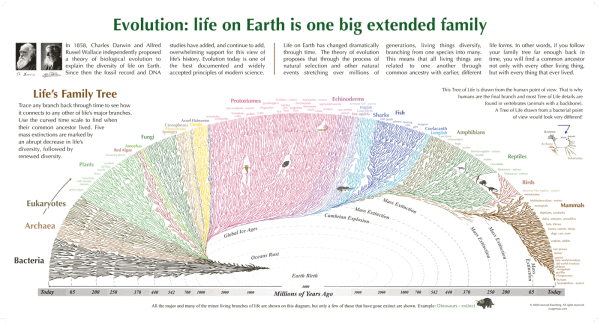 Image credit: Leonard Eisenberg, 2008, via http://www.evogeneao.com/.
Image credit: Leonard Eisenberg, 2008, via http://www.evogeneao.com/.
They weren't all "poofed" into existence in the span of a few days; it took hundreds of millions of years for animals to emerge and diversify. That is a hypothesis that can be treated scientifically, and quite emphatically falsified.
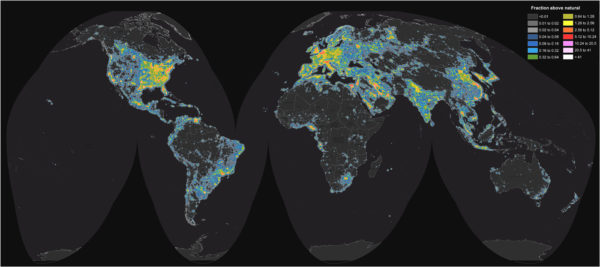 World map of current light pollution. Image credit: F. Falchi et al., “The new world atlas of artificial night sky brightness,” Science Advances, 10 Jun 2016.
World map of current light pollution. Image credit: F. Falchi et al., “The new world atlas of artificial night sky brightness,” Science Advances, 10 Jun 2016.
From dean on the disappearing night skies: "There is a dark park in Michigan as well, just outside of Mackinaw City. It’s very nice, but a bit of a sad reminder that what could once be seen from many rural back yards (the farm where I grew up, for example) and other locales is now not nearly as easy to find."
The eastern half of the United States is particularly bad for light pollution, but like I said, there's virtually nowhere you can be where the Milky Way is more than a two hour drive away. It's not as easy to find, but it isn't impossible. Taking the time to connect with the Universe, at least to me, is more than worth it. More than that, there's a list of dark sky parks in the world here, and Lake Hudson State Recreation Area in Michigan happens to be one of them. It's even fairly close to Detroit, so you don't have to venture to/near the upper peninsula to see it! Check out their full brochure here.
And just to warn you, we had the most comments arise from the second gravitational wave merger from LIGO, so I had to restrict myself to a few...
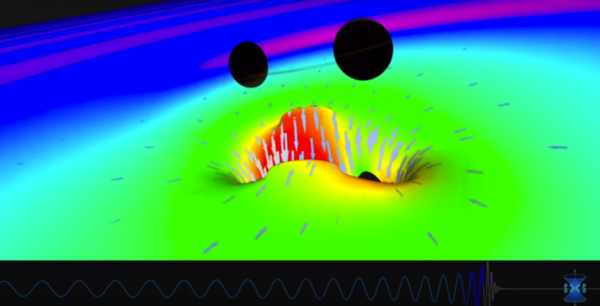 Still from a merging black hole simulation created by the SXS (Simulating eXtreme Spacetimes) Project (http://www.black-holes.org). Image credit: LIGO Lab Caltech : MIT.
Still from a merging black hole simulation created by the SXS (Simulating eXtreme Spacetimes) Project (http://www.black-holes.org). Image credit: LIGO Lab Caltech : MIT.
From Denier on the second black hole merger "Does this prove gravity is quantum in nature?"
Nope. Classical, merging black hole will still produce ripples. The only large-amplitude gravitational wave signal anticipated that's generated from a purely quantum process is the gravitational waves left over from the end of inflation itself: the tensor perturbations at the time of the Big Bang. These are up-for-grabs if they're of large enough amplitude in the next ~15-20 years or so.
From Omega Centauri on more black hole mergers: "WaaHoooo. I can’t wait until we have statistics on the mass spectrum of BH binaries."
What's expected, based on what we know of stars, is that the ~10 solar mass ones should be the most common, ~20 less so, ~30 even less so, ~40 should be rarer, and then there should be a big drop off until there's a spike in the ~100-150 range. Those ~100+ solar mass black holes, though, coming from pair-instability supernovae, should be just at the limit of LIGO's range.
From Paul Dekous on LIGO and supernovae: "No supernova yet, when could we expect those to show up?"
I'll let David Reitze, LIGO's executive director, field that one:
"The supernovae are a really interesting case. When LIGO was first conceived in the late 1970s and 1980s, supernovae were thought to be one of the really good sources of gravitational waves. But as people began to model supernovae better and understand core collapse and the subsequent shockwave and blow-off of the outer layers, they turned out to be rather poor radiators. So Advanced LIGO and even with the next generation, we might be unlikely to detect supernovae outside of our own galaxy."
So unless we have one in our own galaxy, we don't expect them to show up. And even if we do get one in our galaxy, the gravitational waves may still not show up in Advanced LIGO. LIGO is sensitive to neutron star-neutron star mergers out to a few hundred million light years away, to black hole-neutron star mergers out to the same distance and to black hole-black hole mergers up to 9-10 billion light years distant. With the upgrade, we might expect up to 2-3 neutron star-neutron star mergers per month, but we could have our rates wrong. There are other, more exotic possibilities, and we hope that LIGO sees some of those, too. But so far, we've only seen the black holes!
From Omega Centauri on merging black holes: "I suspect merging BH with accretion disks have been modeled. Just how much mass would need to be in the disk(s) to make a signal detectable at 1.e9 lightyears?"
The hard thing about this is that you're basically asking about getting an electromagnetic signal from a billion light years away from a relatively small amount of matter. If you say, "I accept I'll generate a runaway fusion reaction," then perhaps a fraction of a solar mass -- maybe 0.1 solar masses -- would be enough. A "burst" like that would be amazing, and not so different from neutron star-neutron star mergers. But if you just want the gas to get hot and produce X-rays? You'd need at least millions of solar masses, which seems extraordinarily unlikely around such a low mass black hole. I'm sorry I don't have more precise numbers for you than that.
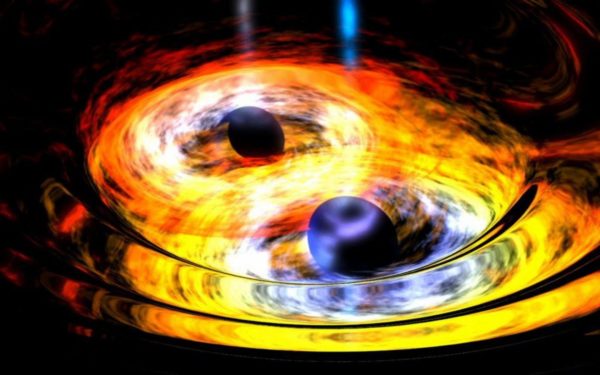 Artist’s impression of two merging black holes, with accretion disks. The density and energy of the matter here is woefully insufficient to create gamma ray or X-ray bursts. Image credit: NASA.
Artist’s impression of two merging black holes, with accretion disks. The density and energy of the matter here is woefully insufficient to create gamma ray or X-ray bursts. Image credit: NASA.
From Naked Bunny With A Whip on detecting hell: "It’s possible that Ethan would write about Hell if theologians ever got around to defining what Hell is, building a Hell detector, and successfully recording the screams of the damned."
I heard that if you hook the Cosmic Microwave Background up to a radio transmitter at midnight on October 31st, it sounds just like Black Sabbath's Iron Man played backwards. But I've never done the experiment myself...
Image credit: ESO/L. Calçada, of the illustration of the dark matter halo surrounding the luminous disk of our galaxy.
From See Noevo on difficult words: "Apparently, there’s not much if any difference between “dense” and “sparse and diffuse”."
All words that scientists use are rarely used in absolute form. For dark matter in the Solar System, it can be considered dense when compared to, say, dark matter in interstellar space, dark matter in the intergalactic medium or dark matter in the outer reaches of the galactic halo. But it can be considered sparse when compared to the density of a molecular gas cloud, the density of dark matter at the galactic center, the density of the Sun or the mean baryonic density of the Solar System. There seems to be a generic language confusion here, so let me hypothesize that words should not be divorced from the context they were used in when cooking up "contradictions."
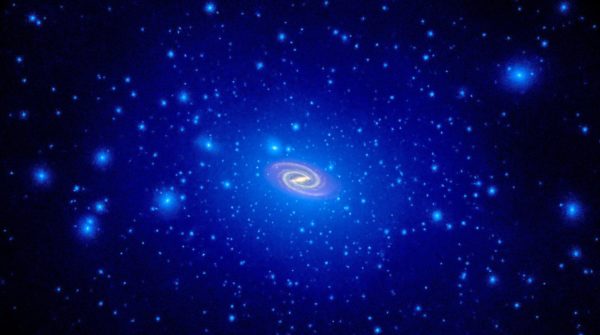 Illustration of a clumpy dark matter halo around the baryons in a galaxy. Image credit: NASA, ESA, and T. Brown and J. Tumlinson (STScI).
Illustration of a clumpy dark matter halo around the baryons in a galaxy. Image credit: NASA, ESA, and T. Brown and J. Tumlinson (STScI).
And finally, from NorEastern on the good old PBH dark matter scenario: "I am not an astrophysicist but I do fail to see how modern astronomy and associated theory can distinguish between a few hundred thousand primordial 30 sol mass black holes and dark matter in the vicinity of the Milky Way."
There are a few ways, but there are at least three direct observations that preclude this:
- Microlensing surveys,
- The fluctuations in the CMB, and
- The fluctuations in the Cosmic Infrared Background.
On the other hand, there's a slew of successful predictions our standard dark matter models make for large-scale structure formation, among many other avenues, that black hole dark matter can't really account for. You may enjoy reading this for a fuller assessment.
Thanks for a great week, everyone, and see you back here tomorrow for even more wonders and joys of the Universe!

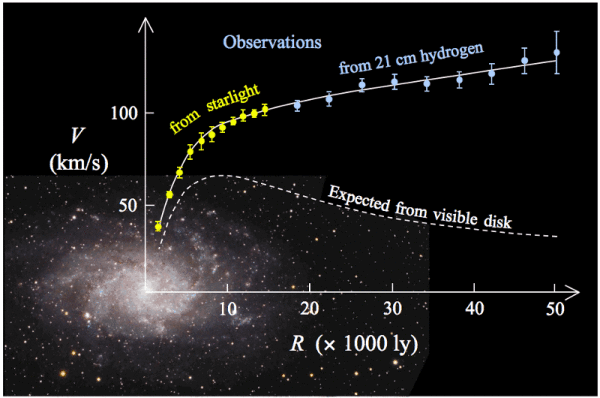
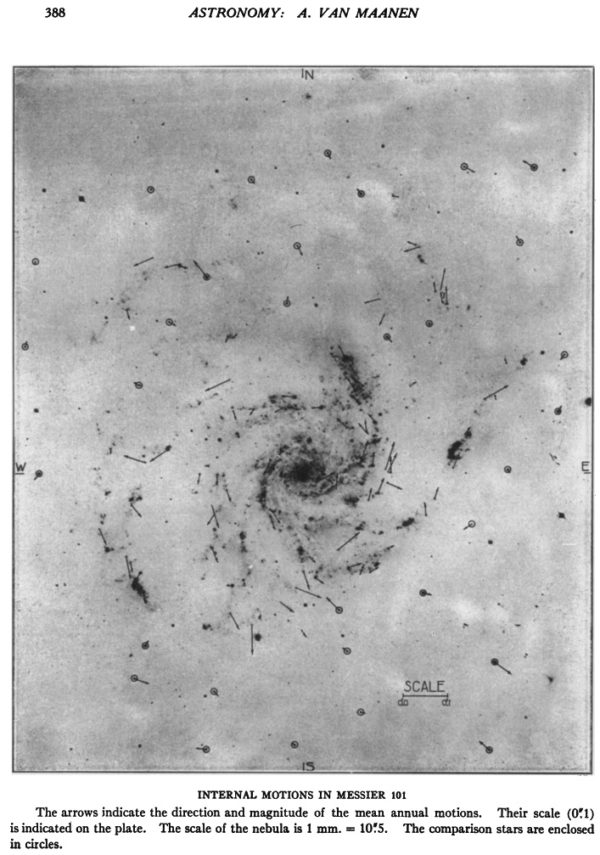

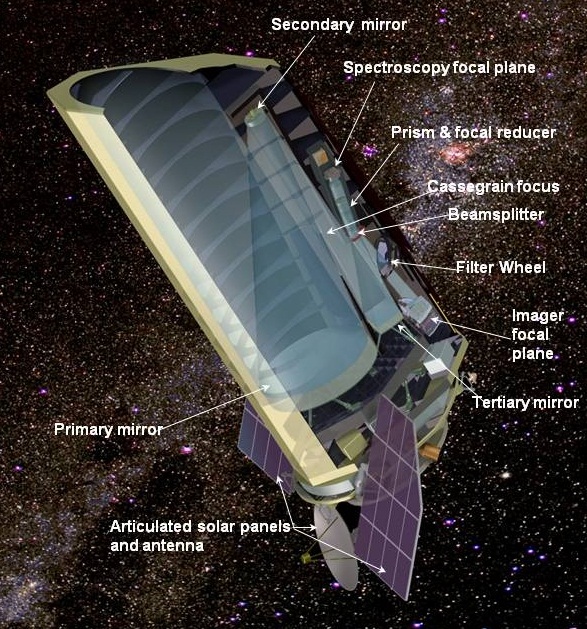

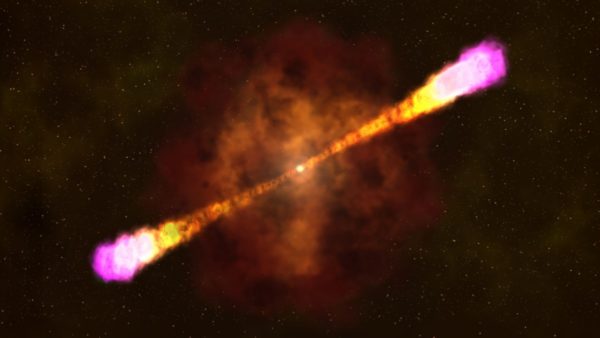
What amazes me is that the Unicode garbage can doesn't include fractional arcseconds and friends (look at the figure legend).
This is pretty rich.
[From See Noevo on difficult words: “Apparently, there’s not much if any difference between “dense” and “sparse and diffuse”.”
“All words that scientists use are rarely used in absolute form. For dark matter in the Solar System, it can be considered dense when compared to, say, dark matter in interstellar space, dark matter in the intergalactic medium or dark matter in the outer reaches of the galactic halo. But it can be considered sparse when compared to the density of a molecular gas cloud, the density of dark matter at the galactic center, the density of the Sun or the mean baryonic density of the Solar System. There seems to be a generic language confusion here, so let me hypothesize that words should not be divorced from the context they were used in when cooking up “contradictions.”]
Firstly, I do NOT think we were talking about *density of a molecular gas cloud* or the *density of the Sun*.
I think we WERE talking about the *density of dark matter.*
I don’t know why you’re bringing up these other things. Maybe as a smoke screen, or rather as a molecular gas cloud?
Secondly, if the density of dark matter in the Solar System is different from that in interstellar space which is different from that in the intergalactic medium which is different from that in the outer reaches of the galactic halo, then, that doesn’t say much for the universe’s alleged "homogeneity", does it?
Thirdly, what’s with your accusation that I’m “cooking up “contradictions”?
I’m just laying out what YOU said and what the Universe Today author said you said.
Are you saying the Universe Today author misrepresented your findings?
Here’s the replay:
“Apparently, there’s not much if any difference between “dense” and “sparse and diffuse.
For Ethan writes
“But on smaller scales, [dark matter is] too sparse and diffuse to impact the motion of the Solar System, the matter here on Earth, or the origin and evolution of humans in any
meaningful way.”
Yet, in an article, which mentions Ethan’s work, titled “Dark Matter is Denser in the Solar System”, we read
“Dark matter isn’t just far off in the Milky Way or somewhere on the other side of the Universe, though: it’s right here at home in our Solar System. In a recent paper submitted to Physical Review D, *ETHAN SIEGEL* and Xiaoying Xu of the University of Arizona analyzed the distribution of dark matter in our Solar System, and found that the mass of dark matter is 300 TIMES MORE than that of the galactic halo average, and the density is 16,000 TIMES HIGHER than that of the background dark matter.”
http://www.universetoday.com/15266/dark-matter-is-denser-in-the-solar-s…
RSVP.
Asked and answered both by Ethan here and by me before.
You refuse to think and are thus unable to read for content. You're an undiluted, trolling, attention whore. Compounding this with intellectual sloth is both disgraceful and disgusting.
“The simplest explanation is the most common one running through scientific history: we fooled ourselves with a barely-observable effect right at the limits of our measurement sensitivity. This is what’s worth noting: that measurement that aren’t independently repeated and significant enough to be beyond all reasonable statistical or systematic doubts shouldn’t be trusted, especially if they would cause something new or novel to exist. This extends to the…”
... to the black hole gravitational waves?
Nah. Probably not. Not in LIGO Land.
They need to show something for $620 million.
“Oh, I disagree with you there, eric. I think “miracle-poofing” animals into existence one day is an eminently testable hypothesis. We can look at the fossil record; we can look at carbon deposits; we can look at the historical emergence of life and see when a variety of different types of life emerged. They weren’t all “poofed” into existence in the span of a few days; it took hundreds of millions of years for animals to emerge and diversify. That is a hypothesis that can be treated scientifically, and quite emphatically falsified.”
Remember, eric, for it’s true:
The entire edifice of Evolution stands on one thing, and ONE THING only.
It’s not biology, or anything that’s ever been observed in nature or in a lab.
It’s not paleontology, or anything that’s ever been observed in the rocks and fields.
No.
The entire edifice of evolution stands on one thing: TIME, specifically, on *man’s presumed infallible measurement of deep TIME.*
Yes, S.N. has now, in a desperate bid for attention, resorted to "replying" to people who haven't commented on the thread.
@5 and @6: I'm okay with SN pointing out that evolution requires more than his 6,000 year old Earth to work. I expect few cosmologists, chemists, physicists, biologists, or even lay readers of Ethan's blog see that point as the critical flaw SN thinks it is.
Ethan:
Ah, but God is omnipotent, and could have poofed the geological column into existence at the same time, so the presence of the column doesn't rule out divine poofing. The concept of God poofing in an old-looking Earth has actually been freighted by young Earth theologians since about the time of Darwin, and its still being used today (by some, not all). Morris claimed this as recently as the 1990s. William Dembski, who is an OEC, has a variant in which he says 'the fall' (rather than God directly) caused a retroactive change in the past to make it look like it does today, wiping out the garden of Eden and replacing it with deep time, etc.
IOW, (in claiming special creation is testable) I think you have underestimated the level of special pleading creationists will go to.
Ethan: "That is a hypothesis that can be treated scientifically, and quite emphatically falsified."
Only if you're talking to someone who is open minded and not willing to retcon a new feature to change the "theory" (as they so often bemoan science of doing, but remember, deflection of your own problems is best done by assigning them preemptively to your opponents).
After all, the meme isn't "poofed into existence", it then gets post-hoc modified into "and poofed all the evidence of fossils into existence" and "changed the laws of physics in the recent past, before we looked". And whatever is needed to pretend that somehow their faith is valid rather than idiocy.
Not one of them can say WHY it bothered.
Hell, not one of them can say WHY there is a god.
After all, they insist there's one because that's why we're here. So what was God's reason to be here?
Ethan, thanks for giving Lake Hudson State Recreation Area its due - it is very nice, and you can camp there, which you can't at the park by Mackinaw.
Still, if you go up north, you're just a hop-skip-and bridge from our U.P., which a great place for hiking, snowshoeing, cycling, and just "getting away from it all."